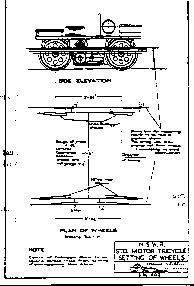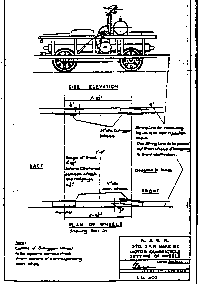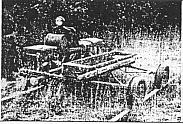|
|
|

|
Preservation and Restoration of NSW Railway Track Vehicles |
|
NSWGR Trikes |

|
©Copyright NSWGR Trikes 2016 |
|
Trikes and Trolleys A short history of track vehicles on the NSWGR
by Greg Lee |
|
Chapter 3 The Quadricycle.
Although mechanised transport first came to N.S.W. fettlers in about 1910, as described in Chapter 1, its use did not become widespread until considerably later.
The motor tricycles or Chase-Me-Charlies which were the first form of mechanised fettlers’ transport in N.S.W. suffered several disadvantages. Starting and mounting was a problem, as described in Chapter1. They also suffered from the inherent instability common to all three wheeled vehicles. The solution took the form of the quadricycle. The first ones were simply a tricycle with an extra wheel fitted. They retained the same engines (3-1/2 h.p. Villiers) and drive arrangements. They also retained the name Tricycle despite having four wheels until sometime in the 1950s when the term Quadricycle was introduced. Quadricycles evolved over the years. A more modern Villiers engine replaced the earlier one; power was decreased from 3-1/2 to 2-1/2 to 2 h.p., and the drive arrangements altered to include a conventional motorcycle clutch and gear box, with kick starter, and with chain drive to the rear wheel.
The gearbox was an Albion model ‘J’, which had 3 forward speeds, but no reverse. Quadricycles, like tricycles could not travel in the reverse direction, due to their peculiar wheel alignment. See Figure 1.
The reason for Tricycles and Quadricycles having this type of wheel alignment lay in the fact that they only drove on one wheel. This naturally tended to push the machines sideways as well as forwards. This sideways push would cause the machines to derail when negotiating right hand curves, if the wheels were not correctly aligned. Many experienced operators, (possibly having experienced the terrifying experience of a Quadricycle derailment) would increase the toe-in dimensions to at least double those shown on the drawings above, especially on lines with sharp curves, such as the Dorrigo line. It was also common practice to carry something heavy, such as a big jack, in the tray of the machine at all times, to help keep it on the rails. It is important not to treat quadricycles roughly, since knocks to the wheels can put the wheel alignment out.
Quadricycles were manufactured at Goulburn Per Way Workshops from the 1920s until the 1970s. They became an extremely common form of fettlers’ transport, and were probably supplied to every fettling gang in N.S.W. at some stage. However, some gangs were not so supplied until the 1960s, up until which time they relied on manual transport. Quadricycles were commonly known as Quads, and were also referred to as Trikes, as were all other track vehicles. Quads were permitted to carry 1 or 2 people, but in emergencies they could accommodate a considerably larger number. They had two seats, and a tray in which to carry tools and materials. Figure 2 shows a quadricycle in their final form.
To remove a quad from the track, one lifts the rear of the machine, turns it to right angles to the track, and then pushes it onto a take-off, or into a trolley shed. To place a quad on the track is a reversal of this procedure. To aid lifting, quads had hand grips extending from the tray, as can be seen in Figure 1 above. Beginning in 1967 the trays of quads were replaced with new ones which included slide-through lifting handles. These handles can be seen in Figure 2.
To lift a quad fitted with these, one first pulls the handles out from the rear of the tray for about half their length. These handles make the task of lifting quads considerably easier, and at the time they were fitted instructions were issued that old gangers were to have their quads attended to first. In their final form quads weighed 3 cwt. 2 qrs. (177 kg). Earlier versions were slightly heavier.
The Rules and Regulations initially limited the speed of Quadricycles to 15 M.P.H., but this was subsequently increased to 20 M.P.H. The machines were capable of speeds in excess of 30 m.p.h., but only the foolhardy would attempt such speed; 30 m.p.h. on a Quad feels like 60 m.p.h.!
One of the perpetual hazards of using trikes was that of unexpectedly meeting a train. There were numerous Rules and Regulations designed to prevent this from happening, but never the less irregularities occurred. Usually the action required (in the pursuit of survival) when faced with a rapidly approaching train was to jump off, and allow the Quad to be smashed to matchwood. The intended way to ride a Quad was to straddle it like a motor bike. Those users with a strong survival instinct would ride them “side saddle”, thus allowing for a speedy dismounting.
The braking arrangement on quads consisted of a small wooden brake block on each of the front and rear main wheels. The former was foot operated, the latter hand operated. The brake blocks initially had a leather lining, but this was later changed to a Ferrodo lining, which was found to be better. In flat country, and in dry conditions these brakes were satisfactory. In the wet and on grades they were very poor and it required skill on the part of the operator to keep the machine under control. Trials were carried out using cast iron brake shoes on the steep Unanderra-Moss Vale line in about 1960. The cast iron shoes were found to be considerably more effective, especially in wet weather, but their use was never generally adopted. During the re-opening of the Dorrigo line by DSRM volunteers in the early 1980s, quads were the main form of transport for some time. Several derailments occurred due to running over small sticks which had fallen from nearby trees. It became apparent that quads were unsuited for use on the Dorrigo line, and after other track vehicles were purchased, the quads were rarely used.
ACKNOWLEDGMENTS Alan Robinson Eddie Tracey.
Figure 1 (SM 402, SM 403) Figure 2. (Photo of Quad by G.L.) |
|
© Greg Lee, 1992 - 1999 |


